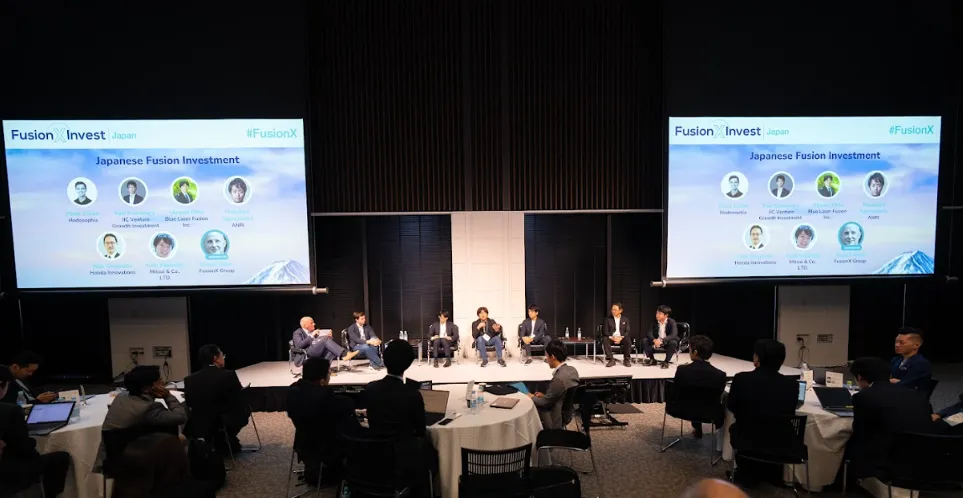Three Key Insights from FusionXInvest:Japan
By Jack Moore, Analyst, Fusion Advisory Services Ltd
The second FusionXInvest event of 2024 took place in a historical centre of global fusion research – Tokyo, Japan. Here are three key insights from the event.
As part of the ITER strategy, Japan has led the way on a ‘Broader Approach’ to fusion, having developed the IFMIF-EVEDA facility for advanced materials testing, as well as JT60-SA, the world’s largest superconducting tokamak. However, as the fusion community moves towards commercialisation, a clear theme emerged from FusionXInvest:Japan – Japan is making a concerted effort to becoming a leader in the private fusion ecosystem.

Jack Moore, Analyst, Fusion Advisory Services Ltd, at FusionXInvest:Japan
1. Fusion Makes Sense for Japan, and Japan Makes Sense for Fusion
In the keynote address, Daisuke Baba, Director of the International Nuclear & Fusion Energy Affairs Division at MEXT & Cabinet Office, laid out the Japanese Fusion Energy Innovation strategy, which includes the creation of a fusion industry council, regulatory alignment with other fusion countries, further support for private sector R&D, and increased support for public-private partnerships. Satoshi Konishi, head of J-Fusion, stated emphatically, “Japan will not miss this opportunity.”
Throughout the event, speakers emphasised why fusion makes sense for Japan. As an island nation without fossil fuel resources, fusion is a pathway for Japan to energy independence. Moreover, the industrial heavyweights located in Japan, such as Sumitomo, Furukawa Electric Co. LTD., and Fujikura LTD., all of whom were in attendance at the event, makes Japan a fertile ground for both fusion commercialisation and future sites for fusion plants.
“Japan is the country of the rising sun,” Konishi stated. “We should have fusion!”
2. Industry globally is Ready To Partner With Fusion Companies
Warrick Matthews, CEO of Tokamak Energy, explained that in an industry like fusion, where there are high capital costs and long timelines, building trust takes time. However, Matthews has seen immense progress in this area in recent years. “When you talk to investors, you don’t have to explain it like it’s science fiction anymore,” he explained. As fusion has moved towards commercialisation, there seems to be a growing understanding for industrial partners that fusion is a viable market.
In particular, panelists at the event pointed to the high temperature superconducting tapes (HTS) industry, of which Japanese companies have a significant market share, as an example of the benefit that occurs when other industries partner with the fusion industry. “Necessity breeds invention,” Matthews explained and the development of HTS tapes to make compact fusion possible has now opened HTS tapes to markets outside of the fusion sector.
Matthews explained that Japanese industry is particularly well-suited to partner with fusion projects. “In Japan partnerships tend not to be for five years, but for the lifetime of the programme, through highs and lows. We see real benefits of doing business here and developing strong partnerships.”
Japanese Fusion Investment panel at the event
3. Fusion Needs Investment and Investors Need Fusion
Throughout the event, panelists made clear that the biggest risk to fusion energy was not science, but financing. “The physics are robust enough that we can begin to put timelines on fusion. You can’t put a timeline on science, but you can put one on engineering,” Proxima CEO Francesco Sciortino explained.
Achieving fusion’s engineering goals requires sufficient investment from private capital. Phil Larochelle, Partner at Breakthrough Energy Ventures, said that whether we overcome the remaining challenges to fusion commercialisation is contingent on whether we commit sufficient resources. “There are about a dozen remaining unsolved challenges,” Larochelle argued. “Do we have the courage to tackle them, and to put in the necessary effort?” Larochelle compared today’s fusion commercialisation push to the Apollo moonshot program, arguing that “fusion needs a starshot.”
Matt Trevithick, CEO of Leitmotif, a decarbonisation venture capital firm, explained that the investment case for fusion today is strong. He pointed out that HTS magnets have enabled smaller plant designs, which will have lower overhead costs, de-risking investment. Trevithick further noted the opportunity for corporations to invest in the fusion space today. Trevithick made an analogy to the electric car market, explaining that Mercedes’ investment in Tesla is now more valuable than Mercedes itself. Given the potentially massive market cap for fusion, given global energy markets, there may be similar opportunities in some of the fusion companies today.
The FusionXInvest:Japan crowd got an up-close view of one such partnership during the conversation between Benj Conway, CEO of Zap Energy, and Shinichi Tsudoda, Operating Officer & General Manager of Sustainable Business Promotion Department at Mizuho Financial Group. Tsudoda explained that they believe that fusion is close enough to commercialisation that it can contribute to Mizuho’s carbon neutrality agenda. While Conway explained that it is increasingly possible to find partners in fusion that are “closest friend” investors, who are shareholders.
Overall…
The optimism coursing through the Tokyo Convention Center at FusionXInvest:Japan this past week has made clear that stakeholders across the fusion industry believe that fusion commercialisation is coming soon, and they are doing the work to help achieve it.
Be sure to sign up for the next FusionXInvest in spring 2025 in California and be a part of the movement!
https://www.fusionxinvest.com/

